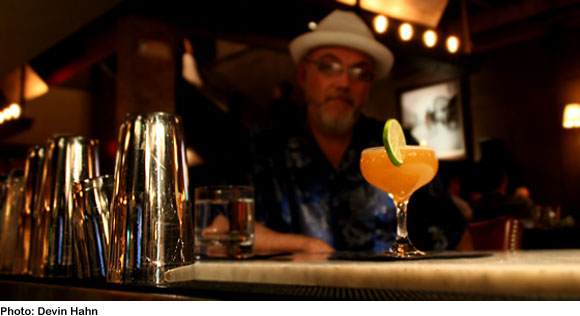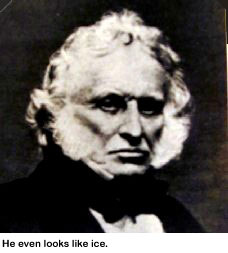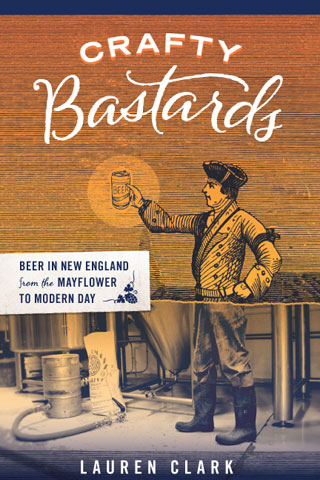Posts Tagged ‘cocktail history’
March 7th, 2011

Hey, cats and kittens, something very cool launches TONIGHT at Think Tank in Kendall Square: Drink This! With Brother Cleve, the godfather of the Boston cocktail world. Join drinkboston, Classic Mixology and the Boston Shaker at 8:00 p.m. for Lundi Gras cocktails as we kick off “a new event series that will put me back behind the bar for the first time since 2001,” says Cleve. Here’s his write-up about the series:
“I’ll be featuring a different set of classic cocktails and new libations of my own creation every Monday, plus selecting the musical soundtrack to pair it with. We’ll be featuring appetizer specials and drink/food pairings from the kitchen, and I’ll hold a little seminar to explain the history of the drinks and assorted cocktail lore. As many of you know, I’ve been studying this stuff for a long time, and we now live in amazing times for spirits drinkers, with so many formerly “lost” liquors, bitters, syrups etc available again for the first time in decades. When Combustible Edison first hit the road in ’94, in search of the “Cocktail Nation,” you were lucky if you could get a decent Martini anywhere. Now, great cocktails are ubiquitous around the globe!
“Our launch date, March 7, coincides with Carnival — Lundi Gras is the Monday before Mardi Gras in New Orleans, so in honor of the occasion we’ll hold a pre-Lenten bash with Cleve’s Ninth Ward cocktail (a “best of show” libation at Tales Of the Cocktail in 2008, now served in select bars around the country), the Ward Eight, Boston’s best known drink and the inspiration for the Ninth Ward, as well as the Sazerac, the venerable favorite that has been designated the Official Cocktail of the City of New Orleans. There will be a soundtrack of classic New Orleans R&B, funk and jazz for your imbibing pleasure.
Cleve brings his knowledge and passion for mixology to these weekly seminars, in which he’ll share classic as well as “lost” recipes from his vast bartending library (collected over the past 25 years) along with new concoctions of his own creation. Each week will showcase a different theme or spirit, and will also feature music and videos culled from Cleve’s personal collection. Special menu items from the kitchen will also be available, and certain evenings will highlight food/cocktail pairings.”
No cover, no reservations, just show up. See you there!
Tags: Brother Cleve, cocktail history, Monday, seminar, Think Tank
Posted in Cocktails, Events, New Orleans | 7 Comments »
April 9th, 2010
 Once upon a time, when adults said, “Let’s get together for drinks,” they meant highballs. Guests would bring a bottle of their preferred hooch to someone’s backyard, and the hosts would provide the tall glasses, ice and mixers — tonic, ginger ale, Squirt. Lots of smoking and guffawing would ensue before everyone drove home tipsy without seat belts.
Once upon a time, when adults said, “Let’s get together for drinks,” they meant highballs. Guests would bring a bottle of their preferred hooch to someone’s backyard, and the hosts would provide the tall glasses, ice and mixers — tonic, ginger ale, Squirt. Lots of smoking and guffawing would ensue before everyone drove home tipsy without seat belts.
Contemporary society goes against all that. It not only sensibly condemns the smoking and drunk driving, it sadly also dismisses the most basic form of mixed drink, the highball. We have bazillions of cocktail choices now, and, unlike the highball drinkers of yore, we talk about them endlessly (damn drinks bloggers).
In celebration of World Cocktail Week (May 6-13), let’s re-embrace that simple pleasure of the booze universe. Join drinkboston and Trina’s Starlite Lounge for Bourbon & Gingers, Presbyterians, Gin & Tonics, Moscow Mules and other members of the highball family — all with quality spirits and featuring house-made mixers — and party like it’s 1965. The details:
- Highballs! Hosted by drinkboston and Trina’s Starlite Lounge (3 Beacon St., Somerville)
- Sunday, May 9 (yes, Mother’s Day — bring mom!)
- 7:00 p.m. until last call
- $35 in advance, $40 at the door
- Highballs include bourbon & housemade gingerale, Presbyterian (rye, housemade gingerale, seltzer), gin & Q Tonic, Moscow Mule (vodka, fresh lime, housemade gingerale), Tom Collins (gin, fresh lemon, simple syrup, seltzer) and Calamansi Collins (the Starlite’s own creation with Thai basil-infused gin, calamanzi juice, simple syrup and seltzer).
- Tickets include four highballs, such retro delights as pigs in a blanket, and DJ-spun, highball-appropriate tunes.
- Call the Starlite at 617-576-0006 to purchase your ticket in advance, as there’s a good chance we’ll sell out.
- Wear whatever you like, but anyone who shows up dressed as stylin’ as Dean Martin (or his date) will get extra credit.
Where does the term “highball” come from? Several sources trace it to the Irish expression “ball of malt,” which became Americanized in the late 1800s to “ball of whiskey” — both terms meaning a measure of whiskey. If a saloon patron wanted a longer drink with carbonated water, he asked for a “highball.” Then there’s the “highball” of railroad lingo — a signal, originally a ball hung above the tracks, indicating full speed ahead — that provides a fun double meaning.
 Did the scotch highball originate in Boston? This amazing article from the October 22, 1927 edition of the New York Times indicates as much. (Note the characteristic snark toward Boston.) Here’s some intel on William T. Adams, who wrote books for boys under the pen name Oliver Optic, and the Adams House hotel. It seems the NYT was lax in its fact-checking here — the Adams House was established by William T.’s father, not his son.
Did the scotch highball originate in Boston? This amazing article from the October 22, 1927 edition of the New York Times indicates as much. (Note the characteristic snark toward Boston.) Here’s some intel on William T. Adams, who wrote books for boys under the pen name Oliver Optic, and the Adams House hotel. It seems the NYT was lax in its fact-checking here — the Adams House was established by William T.’s father, not his son.
But wait, this DrinkBoy forum thread appears to contain a quote from a letter to the editor in the October 27, 1927 NYT by famed bartender Patrick Gavin Duffy, who makes a case for having first introduced the scotch highball in New York.
Whatever. All I know is that I’m craving a scotch and soda with a fried oyster on a toothpick. See you on May 9!
Tags: Adams House, Boston history, cocktail history, highballs, Trina's Starlite Lounge
Posted in Events, Whiskey | 7 Comments »
June 12th, 2009
 The first definition of “cocktail” appeared in a newspaper in 1806. The same year, Frederic “the Ice King” Tudor’s first commercial shipment of ice left Boston harbor. Coincidence?
The first definition of “cocktail” appeared in a newspaper in 1806. The same year, Frederic “the Ice King” Tudor’s first commercial shipment of ice left Boston harbor. Coincidence?
Maybe, but there’s no denying that the ice trade and cocktails came of age together in the 1800s. Boston, and by extension New England, tend to get overlooked in cocktail histories, what with the likes of New York, San Francisco, New Orleans, L.A. and even London making greater claims to fame when it comes to actual drink invention. But cocktails wouldn’t have been invented in the first place without ice. Which brings us to Boston.
Ice from New England’s ponds and rivers had been harvested for a long time before Tudor came along, but he was the first guy to bet that people would actually pay for the stuff. His first markets were places where ice was hard or impossible to come by: the West Indies, New Orleans, Charleston. (His first ice source was Fresh Pond in Cambridge.) But he later extended his business even to cooler places by offering a uniform product that became cheaper and cheaper through innovation in harvesting and delivery. We’re not just talking ice cubes, we’re talking ice boxes and ice houses and a slew of industries becoming dependent on the refrigeration the ice provided: fishing, meat processing, brewing, hospitals. By the 1850s, Tudor was shipping ice all over the world. He got rich — he was one of America’s first millionaires — and he pioneered an entire industry with many competitors. The industry was a significant part of New England’s economy until machine-made ice made it obsolete in the late 1800s/early 1900s.
There’s a fascinating description of the rise and fall of the New England ice trade in a book by an MIT business professor, James Utterback: Mastering the Dynamics of Innovation. I’m not kidding. I never get tired of reading sentences about Yankee ingenuity: “It was the resourcefulness of Tudor, and other Bostonians who became his competitors, that prompted historian Daniel Boorstin’s remark that ‘Using the sea, New England versatility made the very menaces of the landscape [granite, ice] into articles of commerce,'” writes Utterback.
But my favorite passage in the chapter (sexily titled “Invasion of a Stable Business by Radical Innovation”) is about one of Tudor’s rivals — Gage, Hittinger and Company — trying to break into the British market in 1842:
Hittinger knew that the tradition-bound British would not use ice unless they were shown how, so he hired a number of Boston bartenders and took them to London on a ship scheduled to arrive before the ice. When the cargo of “cold comfort” arrived, Hittinger and his bartenders were already set up in an opulent and brightly illuminated hall and there “initiated the English into the mysteries of juleps, cocktails” and “Boston notions” of various types. Before long, fashionable Britons were hooked on New England ice.
“Boston notions!” What the hell were those, I wonder?
Boston drinkers, know the story of the Ice King, so that when you cross paths with some New Yorker or San Franciscan who thinks his city pioneered cocktails, you can give him a smirk and tell him that your city invented friggin’ ice for chrissake.
Tags: cocktail history, Frederic Tudor, New England ice trade
Posted in Books & resources | 4 Comments »

 Once upon a time, when adults said, “Let’s get together for drinks,” they meant highballs. Guests would bring a bottle of their preferred hooch to someone’s backyard, and the hosts would provide the tall glasses, ice and mixers — tonic, ginger ale, Squirt. Lots of smoking and guffawing would ensue before everyone drove home tipsy without seat belts.
Once upon a time, when adults said, “Let’s get together for drinks,” they meant highballs. Guests would bring a bottle of their preferred hooch to someone’s backyard, and the hosts would provide the tall glasses, ice and mixers — tonic, ginger ale, Squirt. Lots of smoking and guffawing would ensue before everyone drove home tipsy without seat belts. Did the scotch highball originate in Boston? This amazing article from the October 22, 1927 edition of the New York Times indicates as much. (Note the characteristic snark toward Boston.) Here’s some
Did the scotch highball originate in Boston? This amazing article from the October 22, 1927 edition of the New York Times indicates as much. (Note the characteristic snark toward Boston.) Here’s some  The first definition of “cocktail” appeared in a newspaper in 1806. The same year, Frederic “
The first definition of “cocktail” appeared in a newspaper in 1806. The same year, Frederic “